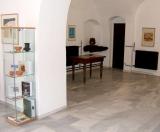2024. April 20. Saturday
Xántus János Museum - Győr

|
Address: 9022, Győr Széchenyi tér 4.
Phone number: (96) 310-588, (96) 524-888
E-mail: xantus@gymsmuzeum.hu
Opening hours: 01.1001.04.: Tue-Sun 10-16
|
The building called the 'Iron Log House' is one of the nicest buildings in Győr. It hosts the Patkó Imre collection of the Xantus János Museum. The house belonged to the chapter of Győr until the end of the 16th century. In 1833, the tradesman Zittrich Mátyás bought it. He put out an iron log under the balcony as the sign similar to those in Vienna.
The Iron Log house was a civic dwelling house until the middle of 1980's. The facade was first renovated in 1962. The complete renovation was done by the architect Szőcs Sándor in 1985-86.
Patkó Imre was born in Gyoma in 1922. He worked as a journalist from the second part of the 40's. He oversaw the Foreign Broadcasting of Hungarian Radio in 1956. After the revolution he worked for the Telegram Office. He edited the foreign policy programs and later was correspondence from Peking and London. Afterwards he became a diplomat, advisor at the Hungarian Embassy in Paris and was head of the public relation office.
Patkó Imre, who spoke six languages, was a successful journalist but he became interested in fine art in the 1960's. He received his diploma from the Fine Arts Department of Elte in 1972. Since then, he wrote more about fine art.
He could feed his interest during his stay and work in Paris. He could also add a number of artworks by artists living in Paris and foreign artists to his collection. He played important part in introducing intellectuals living in Hungary and abroad to each other.
Patkó Imre's last wish was to keep his collection together and show it to the audience in large. Győr-Sporon County provided one of the nicest buildings for the cause. The showing of the collection opened in this renovated building on 8 May 1986.
The Iron Log house was a civic dwelling house until the middle of 1980's. The facade was first renovated in 1962. The complete renovation was done by the architect Szőcs Sándor in 1985-86.
Patkó Imre was born in Gyoma in 1922. He worked as a journalist from the second part of the 40's. He oversaw the Foreign Broadcasting of Hungarian Radio in 1956. After the revolution he worked for the Telegram Office. He edited the foreign policy programs and later was correspondence from Peking and London. Afterwards he became a diplomat, advisor at the Hungarian Embassy in Paris and was head of the public relation office.
Patkó Imre, who spoke six languages, was a successful journalist but he became interested in fine art in the 1960's. He received his diploma from the Fine Arts Department of Elte in 1972. Since then, he wrote more about fine art.
He could feed his interest during his stay and work in Paris. He could also add a number of artworks by artists living in Paris and foreign artists to his collection. He played important part in introducing intellectuals living in Hungary and abroad to each other.
Patkó Imre's last wish was to keep his collection together and show it to the audience in large. Győr-Sporon County provided one of the nicest buildings for the cause. The showing of the collection opened in this renovated building on 8 May 1986.
